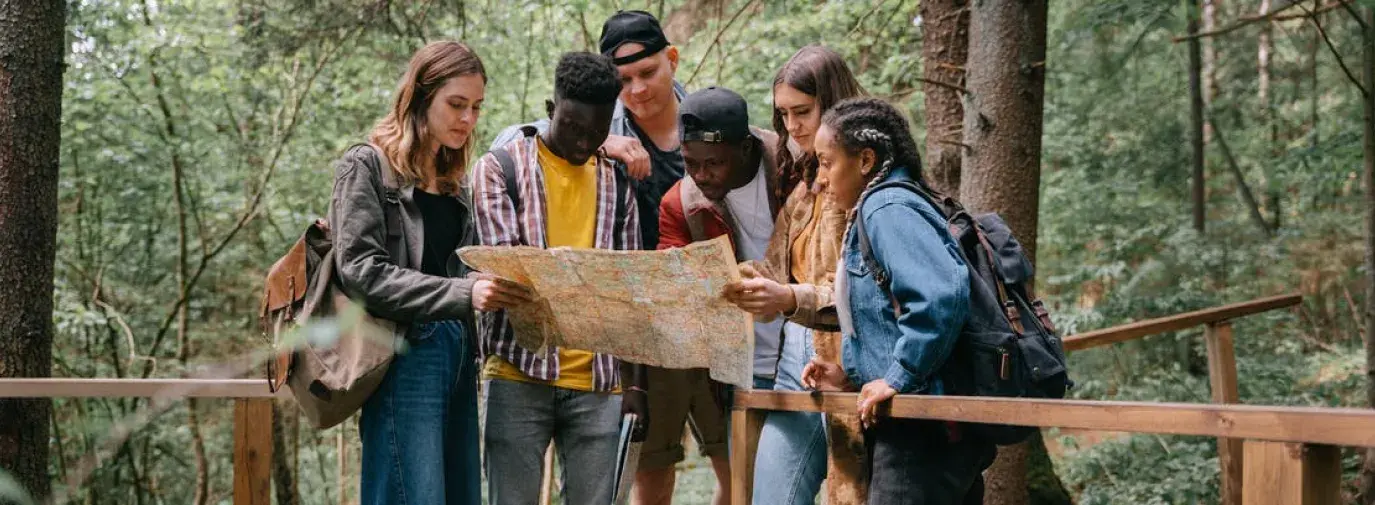
Masks and distancing remain as COVID cements its presence, but the world still calls. Traveling is happening again, as weddings resume and that private rental on the beach beckons.
But while traveling is a great way to appreciate the world, or, more safely, your city or state, by immersing yourself in diverse lands, histories, and traditions. It can also wreak havoc with carbon footprints, disruption of local ecosystems, and more.
But that unexplored neighborhood in your city is calling, and you can answer—sustainably.
Travel Slow
You’ve been anxiously waiting to stretch those travel legs and we understand the desire to hit the ground running. But while tour groups may encourage thirteen countries in just seven days, sometimes the best way to take it all in is by slowing it all down. Rather than exploring a new place in the fast lane, stop by the visitor center or do an online search for local walking, biking, and hiking tours to travel slowly and sustainably.
Carolyn Crouch, founder of Washington Walks, the first company to offer walking tours of our nation’s capital, says it plainly: “The beauty of a walking tour, apart from the fact that it is inherently sustainable, is that it’s also slow travel.”
By exploring a new place on foot, tourism becomes more intimate as you consider the immediate locale around you, whether that be in local restaurants or historic neighborhoods. “I love that about walking tours,” says Crouch, whose tours may take two hours to travel a single mile. “It allows you to take a concentrated experience of a city home with you.”
Planning and Packing
When it comes to travel, planning and packing is part of the fun, so before you even set sail, consider the small ways you can make your next adventure greener.
Packing a reusable water bottle and toiletries (bar shampoos and soaps from Tangie and Vermont Soaps travel especially well) will save money and reduce plastic use. Before you leave, research public transit, and as always, living a more eco-friendly life revolves around habit-building, so re-adjust the thermostat and turn off the lights before leaving your hotel room for the day, and pass on linen and towel service when you can.
Make sure you also pack plenty of masks for whenever you’re using transportation or in crowded spaces.
Stay Local
When visiting a new city, you can find joy—and sustainable travel—in getting to know a place from the ground up.
“You could do something quite extraordinary if you said, ‘I’m going to dine at locally owned places, I’m going to see about accommodations in a home or a small inn operated by locals,’” Crouch says. “Then you’re really contributing to the local economy.”
For example, if you’re heading to the Blue Ridge Mountains in Virginia, consider a stay at Montfair Resort Farm. Further north, you can find Thyme in the Country B&B in the Hudson Valley region of New York.
Voting with your dollar is not a concept that only exists where you live. As a visitor, you can give back to the city welcoming you by supporting small businesses, local restaurants, and experiences that pay into the community.
Instead of a magnet that was made overseas from a busy tourist shop, find souvenirs at local brick and mortars or packable food from a farmers market.
Watch Out for Your Footprint
You’ve heard of your carbon footprint, but what about every other footprint you leave wherever you go?
A crucial consideration when traveling is how you will leave a place, including its ecosystem and residents. Strive to leave a positive footprint or, in many cases, no footprint at all.
“Sometimes you can’t help it,” Crouch concedes. “You must get on that motorcoach or plane to get from A to B.”
Do your part, then, to try and offset those emissions by making greener choices elsewhere and buying carbon offsets if you can afford to. If you’re renting a car and can afford it, opt for an electric rental or, as Crouch would encourage, walk as much as you’re able. Public transportation and rental bikes are also fun options.
Finally, understand your presence’s impact on the people and living creatures of your destination.
Travelers can leave bitterness amongst locals when there is a lack of courtesy, which is why it’s important to first and foremost respect wherever it is you’re traveling to and all the living beings who inhabit that place. Especially now, this includes considering the health and safety of the communities you’re going to.
“Research tours and experiences before booking and understand how they impact the local ecological environment, but also the local population, who plays a role in the tourism industry,” Crouch advises.
Advocate for Sustainable Travel
Choosing sustainable travel doesn’t end when the trip is over. Based on what you learned or experienced, start conversations with friends and family, and inspire others to do more. If you have feedback for a restaurant or hotel you patronized, get in touch with them—for example, Crouch has written to accommodations to ask that they stop using Styrofoam and plastic dishware.
Traveling is already overwhelming without considering sustainability, but with the right knowledge, you, too, can become an eco-friendly traveler!
Need Vacation Inspiration? See the National Parks!
There are more than 400 park sites in the National Park System, including historical trails, monuments, preserves, and 63 national parks—sea to shining sea. With more than 318 million visitors each year, America’s national parks are hot spots for local, green vacations. Choose your own adventure with preplanned itineraries designed by the National Park Service that include hikes, tips for wildlife watching, and other great outdoor activities. And make sure to not only recognize what Indigenous land you are visiting but journey to a national park that honors and celebrates Indigenous heritage and history—there are at least 11 that do.
Learn more about visiting during one of the five free-entrance days throughout the year, or get free or discounted passes when traveling with senior citizens, current military members, fourth-grade students, and disabled citizens.
Did you know that the National Park Service website is home to hundreds of wildlife webcams? When you need a change of scenery watch the webcams to sneak a peek at the world’s wonders.







